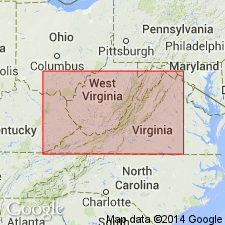
- Usage in publication:
-
- Blackford facies
- Modifications:
-
- Named
- Dominant lithology:
-
- Shale
- Dolomite
- Limestone
- AAPG geologic province:
-
- Appalachian basin
Summary:
Named the Blackford facies of the Murfreesboro formation for Blackford, Russell Co., VA. The Blackford facies makes up the lower 70 feet or less of the Murfreesboro and consists of a heterogeneous sequence of red shale, red mottled argillaceous dolomite, gray shale, gray clay, and gray magnesian crumbly limestone. The basal bed is, in places, a massive layer or two, as much as 5 feet thick, of dull gray dolomitic rock containing many angular fragments of residual chert. The Blackford facies is of Middle Ordovician age.
Source: GNU records (USGS DDS-6; Reston GNULEX).
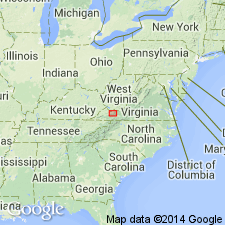
- Usage in publication:
-
- Blackford member
- Modifications:
-
- Revised
- AAPG geologic province:
-
- Appalachian basin
Summary:
The Blackford is revised as the Blackford member of the Cliffield formation in VA. Consists of basal clastics, ash gray shale, and blocky chert beds. Unit disconformably overlies the Beekmantown formation or the Five Oaks limestone member of the Cliffield formation.
Source: GNU records (USGS DDS-6; Reston GNULEX).
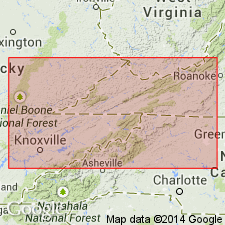
- Usage in publication:
-
- Blackford formation
- Modifications:
-
- Areal extent
- AAPG geologic province:
-
- Appalachian basin
Summary:
Pg. 1145-1148. Blackford formation of Cliffield group. Geographically extended into northeastern Tennessee. [Age is Middle Ordovician.]
Source: US geologic names lexicon (USGS Bull. 1200, p. 362-363).

- Usage in publication:
-
- Blackford member
- Modifications:
-
- Revised
- AAPG geologic province:
-
- Appalachian basin
Summary:
Revised the Blackford as the Blackford member of the Lurich formation in western VA.
Source: GNU records (USGS DDS-6; Reston GNULEX).

- Usage in publication:
-
- Blackford formation*
- Modifications:
-
- Revised
- AAPG geologic province:
-
- Appalachian basin
Summary:
Raised the Blackford to formation rank in VA. Consists of a basal unit (6 to 20 feet thick) of light gray to greenish gray lutite-textured dolomite containing angular chert fragments, a middle unit (about 60 feet thick) of interbedded calcareous shale, calcareous mudstone, and limestone, and upper unit (about 35 feet thick) of interbedded light gray lutite-textured limestone and light-gray calcareous shale. Unit overlies the Mascot dolomite and underlies the Elway limestone. The Blackford is of early Middle Ordovician age.
Source: GNU records (USGS DDS-6; Reston GNULEX).
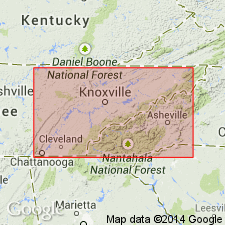
- Usage in publication:
-
- Blackford Formation
- Modifications:
-
- Revised
- AAPG geologic province:
-
- Appalachian basin
Summary:
The Blackford Formation is revised to be included within the Chickamauga Group in eastern TN. It is the lowest most formation in the Chickamauga Group. Unit overlies the Knox Group and underlies the Five Oaks Formation of the Chickamauga Group. The Blackford is of Middle Ordovician age.
Source: GNU records (USGS DDS-6; Reston GNULEX).
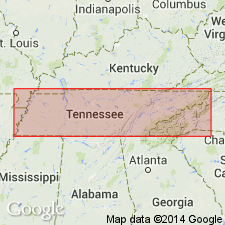
- Usage in publication:
-
- Blackford Member
- Modifications:
-
- Revised
- AAPG geologic province:
-
- Appalachian basin
Summary:
Revised the Blackford as the Blackford Member of the Five Oaks Formation (Chickamauga Group) in eastern TN.
Source: GNU records (USGS DDS-6; Reston GNULEX).

- Usage in publication:
-
- Blackford Formation*
- Modifications:
-
- Areal extent
- AAPG geologic province:
-
- Appalachian basin
Summary:
Geographically extended the Blackford Formation into the subsurface of WV on section F-F'. Unconformably overlies the Beekmantown Dolomite and underlies the Peery, Five Oaks, and Elway Limestones, undivided. The Blackford is of Middle Ordovician age.
Source: GNU records (USGS DDS-6; Reston GNULEX).
For more information, please contact Nancy Stamm, Geologic Names Committee Secretary.
Asterisk (*) indicates published by U.S. Geological Survey authors.
"No current usage" (†) implies that a name has been abandoned or has fallen into disuse. Former usage and, if known, replacement name given in parentheses ( ).
Slash (/) indicates name conflicts with nomenclatural guidelines (CSN, 1933; ACSN, 1961, 1970; NACSN, 1983, 2005, 2021). May be explained within brackets ([ ]).

